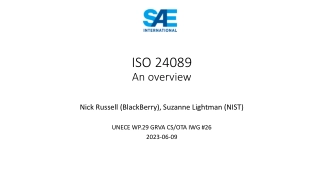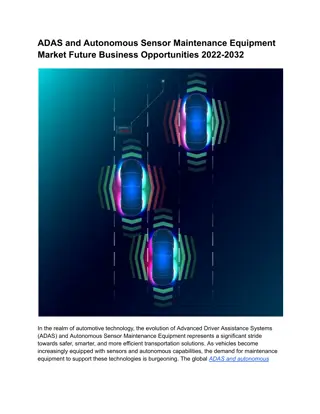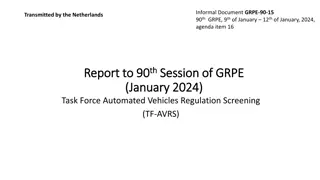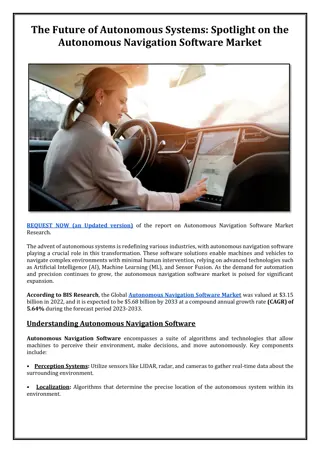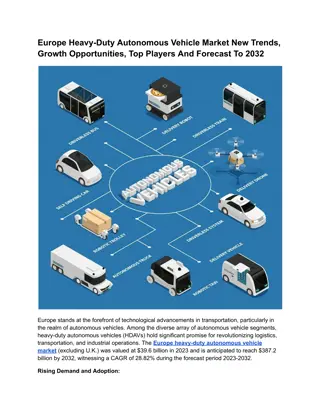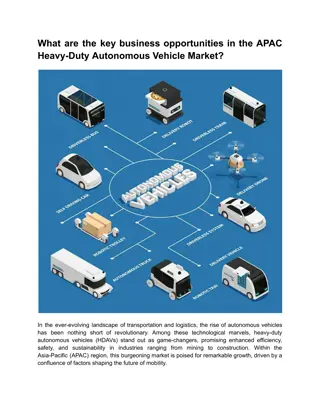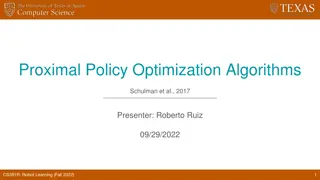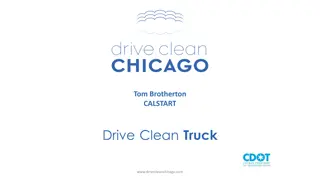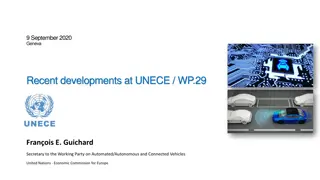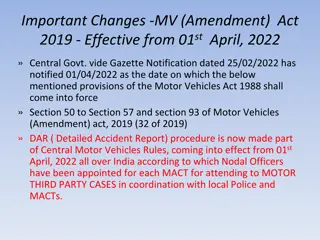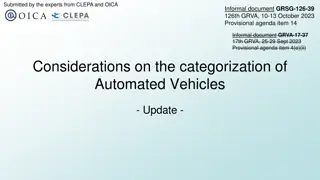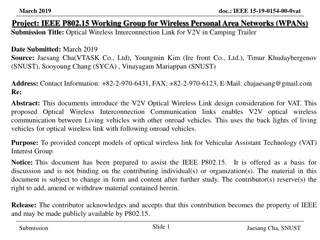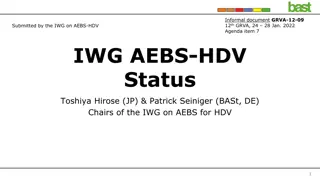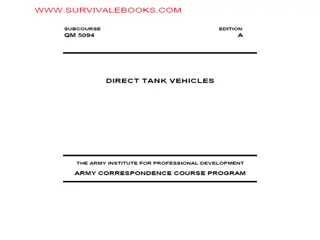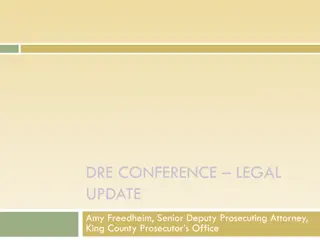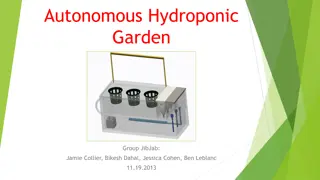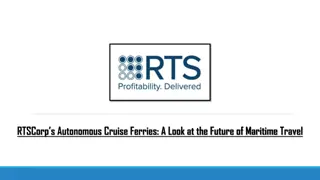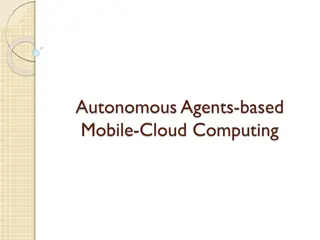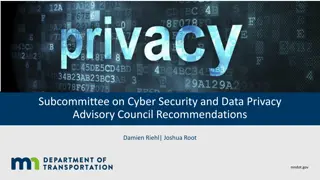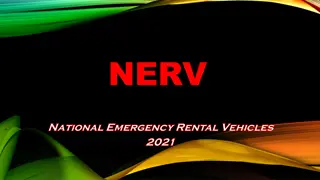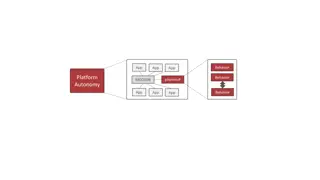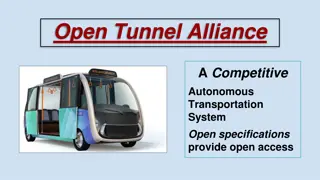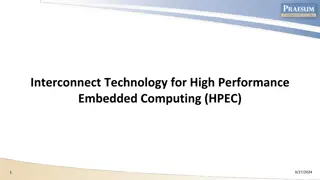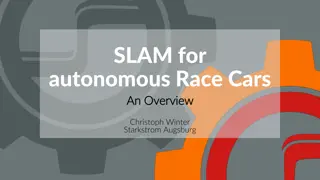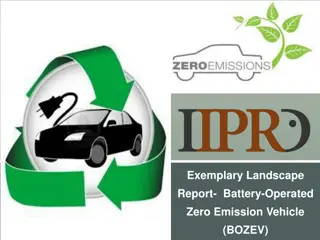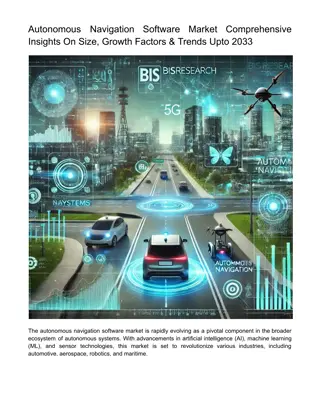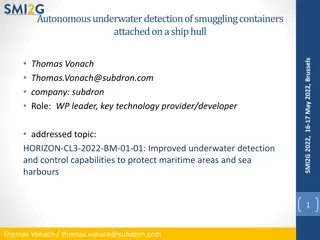Overview of ISO 24089: Software Update Processes in Vehicles
This overview delves into the ISO 24089 standard, focusing on the engineering processes related to software updates in vehicles. It covers the background, scope, coverage, and key terminology, highlighting the importance of safe and secure software updates in modern vehicles.
4 views • 14 slides
Autonomous Software Excellence: Transforming Assessments with vmedulife
Effortlessly manage examination data for autonomous institutes with vmedulife\u2019s Autonomous Software module. From seamless examination scheduling to question paper generation, student enrollment, and efficient handling of pre and post-examination tasks, our system streamlines the entire process
3 views • 5 slides
Electric Vehicle Informal Working Group Progress Report
The report provides an update on the Electric Vehicles and the Environment Informal Working Group's recent meetings, current work on hybrid power determination and in-vehicle battery durability, and developments in GTR-21 and GTR-22. The group is focusing on refining test procedures, considering CAN
2 views • 13 slides
Autonomous Conjunction Assessment Methodology Among Satellites
Methodology for Collision Avoidance (CA) among constellations of autonomously-controlled satellites is crucial for protecting assets in space. From straightforward protection against dead satellites to active coordination for maneuverable payloads, the range of primary-secondary CA possibilities is
1 views • 12 slides
Sustainability Benefits and Transition to LED Technology in Vehicles
Explore the sustainability benefits of LED technology in vehicles, focusing on improvements in energy efficiency and CO2 savings. The transition from halogen to LED technology is projected with significant potential for reducing carbon emissions. The acceleration of this transition through LED repla
3 views • 5 slides
Asia-Pacific Future of Autonomous Systems Market Research Forecast (2023-2033)
The Asia-Pacific Future of Autonomous Systems Market: focus on autonomous navigation software was valued at $691.7 million in 2022, and it is expected to be $1,361.8 million by 2033 growing at a compounded rate (CAGR) of 6.51%.
3 views • 3 slides
ADAS and Autonomous Sensor Maintenance Equipment Market Opportunities 2022-2032
The global ADAS and autonomous sensor maintenance equipment market was valued at $2,704.7 thousand in 2022, and it is expected to grow at a CAGR of 49.68% and reach $1,52,666.5 thousand by 2032.\nRead Report Overview: \/\/bisresearch.com\/industry-report\/adas-autonomous-sensor-maintenance-equipment
4 views • 3 slides
Task Force Automated Vehicles Regulation Screening Report
The Task Force Automated Vehicles Regulation Screening (TF-AVRS) conducted multiple meetings and screenings to evaluate regulations and terms related to automated vehicles. The report outlines the screening process, considered items, results, and future plans for regulation screening in the automoti
0 views • 9 slides
green hydrogen market
green hydrogen is used as fuel to provide a sustainable mobility alternative. Fuel cells make vehicles more efficient and quieter; using green hydrogen allows vehicles to travel longer distances with less refueling. The increase in demand for green hydrogen is also due to growing government initiati
1 views • 3 slides
Future of Autonomous Systems: Spotlight on Autonomous Navigation Software Market
The Global Autonomous Navigation Software Market was valued at $3.15 billion in 2022, and it is expected to be $5.68 billion by 2033 at a compound annual growth rate (CAGR) of 5.64% during the forecast period 2023-2033.
0 views • 3 slides
Europe Heavy-Duty Autonomous Vehicle Market Growth Opportunities 2023-2032
The Europe heavy-duty autonomous vehicle market (excluding U.K.) was valued at $39.6 billion in 2023 and is anticipated to reach $387.2 billion by 2032, witnessing a CAGR of 28.82% during the forecast period 2023-2032.\nRead Report Overview: \/\/bisresearch.com\/industry-report\/europe-heavy-duty-au
2 views • 3 slides
What are the business opportunities in APAC Heavy-Duty Autonomous Vehicle Market
The Asia-Pacific heavy-duty autonomous vehicle market (excluding China) was valued at $34.8 billion in 2023 and is expected to reach $305.3 billion by 2032, growing at a CAGR of 27.28% during the forecast period 2023-2032.\nRead Report Overview: \/\/bisresearch.com\/industry-report\/asia-pacific-hea
1 views • 3 slides
Energy Consumption Test Methods for Heavy-Duty Commercial Vehicles in China
China has released energy consumption testing methods for various types of fuel vehicles, including traditional fuel vehicles, hybrid electric vehicles, battery electric vehicles, fuel cell vehicles, natural gas vehicles, and methanol vehicles. The standards cover test methods for fuel consumption a
4 views • 15 slides
Advanced Reinforcement Learning for Autonomous Robots
Cutting-edge research in the field of reinforcement learning for autonomous robots, focusing on Proximal Policy Optimization Algorithms, motivation for autonomous learning, scalability challenges, and policy gradient methods. The discussion delves into Markov Decision Processes, Actor-Critic Algorit
6 views • 26 slides
Drive Clean Truck Incentive Program Details
Drive Clean Truck initiative in Chicago offers point-of-sale incentives to move fleets towards zero and low-emission vehicles, focusing on Class 2 to Class 8 trucks and buses. The program, funded by the Chicago Department of Transportation and administered by CALSTART, issued $11.3M for 288 trucks a
0 views • 9 slides
Highlights of Recent Developments at UNECE/WP.29 in Geneva
Key developments at UNECE/WP.29 in Geneva include the adoption of new UN regulations on ALKS, CS, CSMS, SU, SUMS, and cyber security. Frameworks like the 1998 Agreement and 1958 Agreement play crucial roles in regulating automated/autonomous vehicles. The focus is on enhancing safety, transparency,
0 views • 15 slides
Important Changes in Motor Vehicles Act 1988 and Motor Vehicles Amendment Act 2019
Central Government has announced amendments to the Motor Vehicles Act 1988 and Motor Vehicles Amendment Act 2019 effective from April 1, 2022. The changes include the implementation of Detailed Accident Report procedures, appointment of Nodal Officers for motor third party cases, and definitions rel
1 views • 18 slides
Update on Categorization of Automated Vehicles by OICA and CLEPA
OICA and CLEPA are updating the categorization of automated vehicles, introducing new subcategories and refining definitions for driverless and dual-mode vehicles. The work aligns with ongoing efforts in related groups and aims to enhance clarity in classifying different types of automated vehicles
0 views • 12 slides
Optical Wireless Interconnection Link for V2V in Camping Trailer
Introducing a design concept for Optical Wireless Communication Link for Vehicular Assistant Technology (VAT), enabling V2V communication between living vehicles and other on-road vehicles. Utilizing back lights of living vehicles, this system aims to improve visibility and safety on the road, espec
0 views • 5 slides
Update on Informal Working Group Activities for AEBS in Heavy-Duty Vehicles
The Informal Working Group on AEBS for Heavy-Duty Vehicles has made significant progress in developing a draft regulatory proposal to revise UN Regulation No. 131. Key tasks include assessing accident situations, exploring a generic marker triggering AEBS, defining performance requirements, and more
8 views • 9 slides
Proper Petroleum Marking and Inspection Guidelines for Vehicles and Equipment
As a petroleum supervisor, it is essential to inspect vehicles and equipment to ensure proper markings, preventing commingling of products and ensuring safety. This lesson covers the inspection of petroleum markings on tank vehicles, safety markings for bulk transportation, marking requirements for
0 views • 152 slides
Hailey's Law Update: Mandatory Impound for DUI Arrests
Mandatory Impound under Hailey's Law requires a twelve-hour hold on vehicles used by individuals arrested for DUI or physical control. Non-commercial or non-farm transport vehicles must be towed, and vehicles with arrested drivers as the registered owner cannot be redeemed for 12 hours. Commercial o
1 views • 18 slides
Autonomous Hydroponic Garden Project Overview
The Autonomous Hydroponic Garden Project, led by a group of individuals, aims to create a household garden system using key components like temperature control, pH monitoring, and more to sustain specific plants such as tomatoes and basil. The project involves CAD designs, purchased parts, levels of
0 views • 10 slides
RTSCorp’s Autonomous Cruise Ferries A Look at the Future of Maritime Travel
The maritime industry is on the brink of a revolutionary transformation with the advent of autonomous technologies, and RTSCorp is at the forefront of this change. With the introduction of their cutting-edge autonomous cruise ferries, the company is
3 views • 6 slides
Enhancing Mobile-Cloud Computing with Autonomous Agents Framework
Autonomous Agents-based Mobile-Cloud Computing (MCC) refers to moving computing tasks to powerful centralized platforms in the cloud, offering advantages like extending battery life and dynamic resource provisioning. However, an inflexible split of computation between mobile and cloud platforms lead
0 views • 22 slides
Boston Public Schools Autonomous Schools Overview
Boston Public Schools (BPS) offer various autonomous schools, including Innovation Schools, Pilot Schools, Turnaround Schools, and Horace Mann Charter Schools. The 2015-16 school year saw an increase in overall enrollment in autonomous schools, with 32% of BPS students attending them. Families are m
1 views • 16 slides
Smart Energy and Autonomous Vehicles Pilot Projects in Helsinki and Tallinn
These pilot projects in Helsinki and Tallinn aim to revolutionize energy distribution and transportation through smart grid technologies and AI-enabled autonomous vehicles. The Helsinki pilot focuses on smart buildings participating in the energy market, while the Tallinn pilot features AI-enabled a
0 views • 14 slides
Fully Autonomous Programming: Advancing Software Development Through AI
Explore the concept of fully autonomous programming using large language models and genetic programming, aimed at enabling more individuals to create software products with a focus on creativity and rapid prototyping. The proposed framework involves synthesizing, executing, instructing, debugging, a
0 views • 11 slides
Cyber Security and Data Privacy Recommendations in Autonomous Vehicles
The recommendations provided by the Subcommittee on Cyber Security and Data Privacy Advisory Council address key considerations such as definitions, data classification, security protocols, public-private partnerships, regulatory frameworks, and data collection, storage, and distribution in the cont
0 views • 26 slides
National Emergency Rental Vehicles Program Overview
The National Emergency Rental Vehicles (NERV) Program provides rental vehicles for personnel from various agencies responding to incidents that require specific vehicle types. This program is managed by NWCG agencies and is not available to contracted resources. Vehicles range from economy cars to h
0 views • 18 slides
Advanced Autonomous Mission Management Tools Overview
This detailed content provides an overview of various advanced autonomous mission management tools used in Shoreside missions. It covers aspects such as behavior analysis, platform autonomy, mission monitoring, launch procedures, evaluation tools, and multi-vehicle mission management. The images inc
0 views • 14 slides
Data Offload Using WLAN in Connected Vehicles
The market for connected vehicles is rapidly growing, leading to increased data consumption. This document highlights the importance of offloading data from cellular networks to WLAN in connected vehicles. Current solutions like 802.11u are insufficient, necessitating new standards to address the ch
0 views • 10 slides
Revolutionizing Autonomous Transportation with Open Tunnel Alliance
The Open Tunnel Alliance aims to revolutionize autonomous transportation by setting standards for tunnel interoperability, enabling various autonomous vehicles to utilize tunnels efficiently. This initiative promotes competition, lowers costs, and enhances access for different vehicle types, ultimat
0 views • 14 slides
Cutting-Edge Interconnect Technology for High-Performance Computing
Explore the world of high-performance embedded computing through images and descriptions detailing key components like terrestrial autonomous vehicles, wireless infrastructure, FPGA-based data exchange, and more. The content dives into fault tolerance, data processing, redundant computing, and hardw
0 views • 12 slides
Understanding SLAM Technology for Autonomous Race Cars
Dive into Simultaneous Localization and Mapping (SLAM) technology used in autonomous race cars. Explore theoretical overviews, implementation methods like Extended Kalman Filter SLAM and Particle Filter SLAM, terms like scan matching and loop-closing, and popular implementations such as GMapping and
0 views • 15 slides
Advancements in Battery-Operated Zero Emission Vehicles (BOZEV)
The report delves into the landscape of Battery-Operated Zero Emission Vehicles (BOZEV), highlighting their eco-friendly nature, cost-effectiveness, and reduced maintenance. It compares BOZEVs with fuel-propelled vehicles, emphasizing the benefits including zero emissions, low noise pollution, and s
0 views • 41 slides
Emerging Trends in Auto Lidar Technology
Developing standardized benchmarking tests for auto lidar performance is crucial, especially with the increasing use of lidar in autonomous vehicles. Alongside lidar, other sensors like radar, cameras, and specialized software play vital roles in ensuring safe and efficient autonomous driving. Safet
0 views • 14 slides
Europe Autonomous Navigation Software Market
Europe future of autonomous systems: focus on autonomous navigation software market is estimated to reach $1,749.7 million by 2033 from $927.3 million in 2023, growing at a CAGR of 6.55% during the forecast period 2023-2033.\n\nRead Report Overview:
1 views • 3 slides
Future of Autonomous Systems - Focus On Autonomous Navigation Software Market
The future of autonomous systems: focus on autonomous navigation software market was valued at $3.15 billion in 2022, and it is expected to be $5.68 billion by 2033.\n\nRead Report Overview: \/\/bisresearch.com\/industry-report\/future-of-autonomous-
0 views • 3 slides
Autonomous Underwater Detection of Smuggling Containers for Maritime Security
Innovative project led by Thomas Vonach of Subdron focusing on enhancing underwater detection capabilities to protect maritime areas and sea harbors. Utilizing Autonomous Underwater Vehicles (AUVs), the project aims to autonomously detect illegal obstacles such as cylindrical containers attached und
0 views • 4 slides
